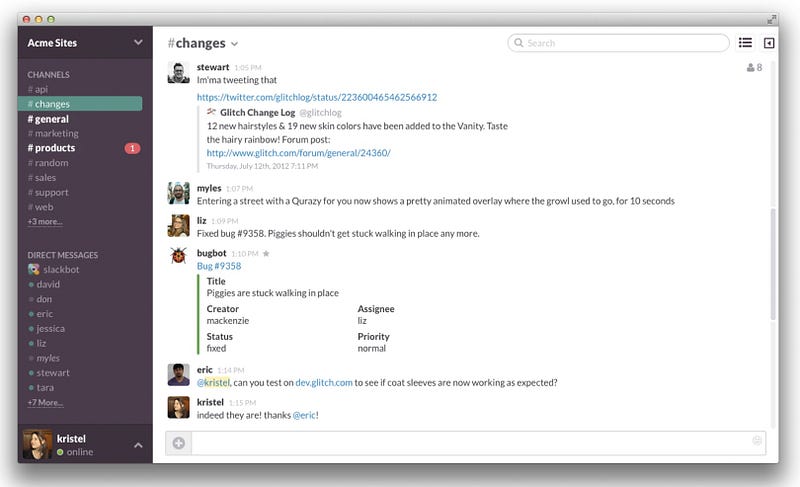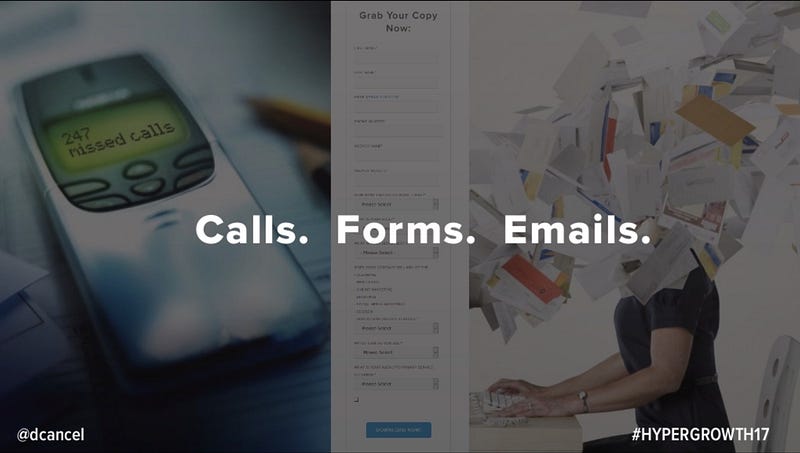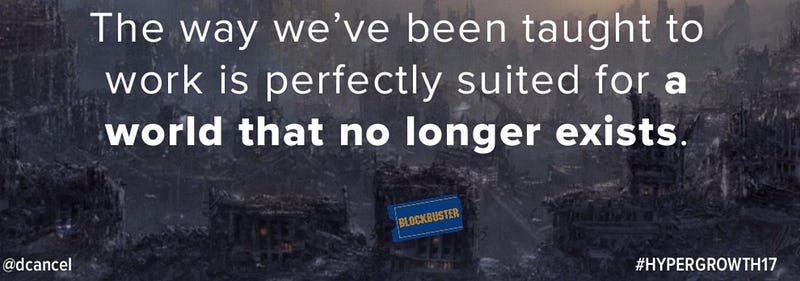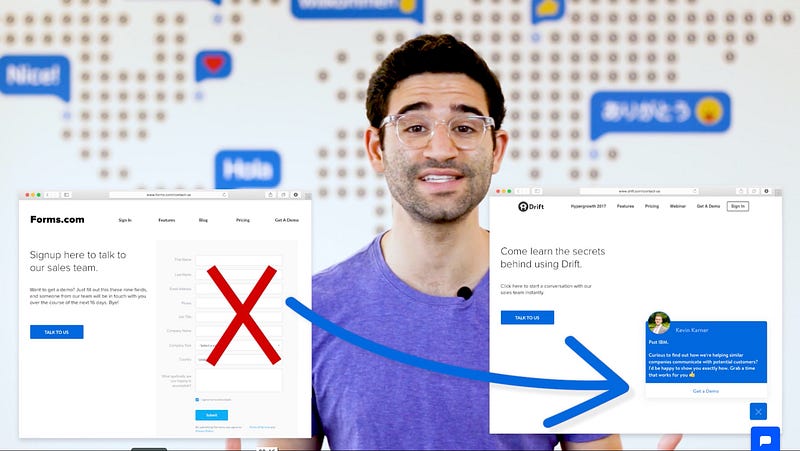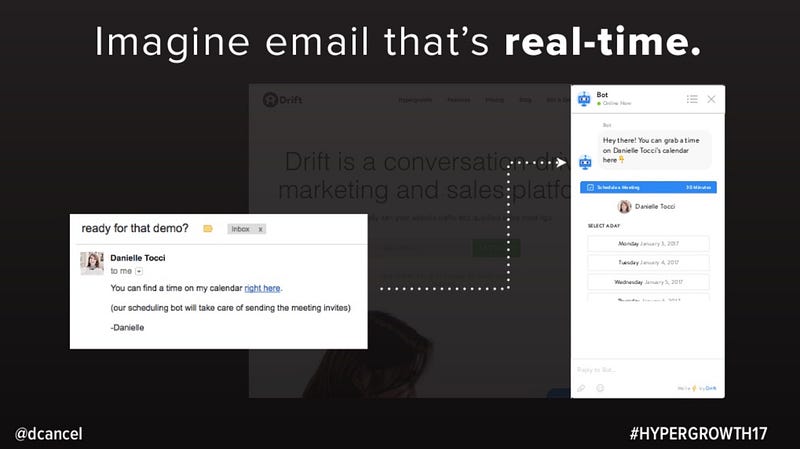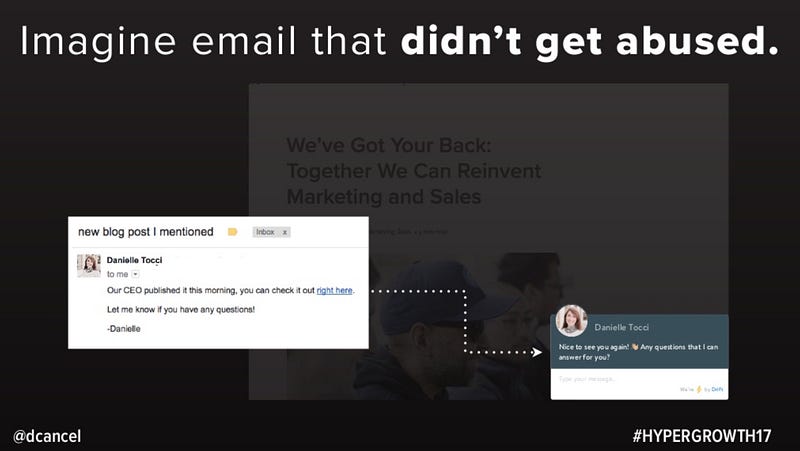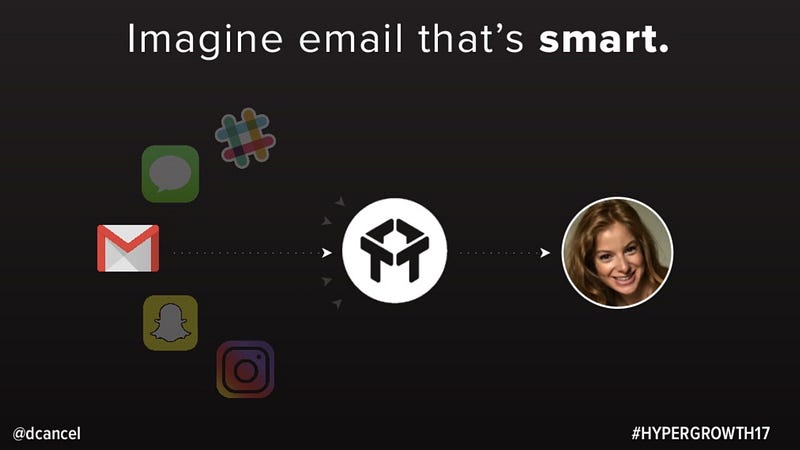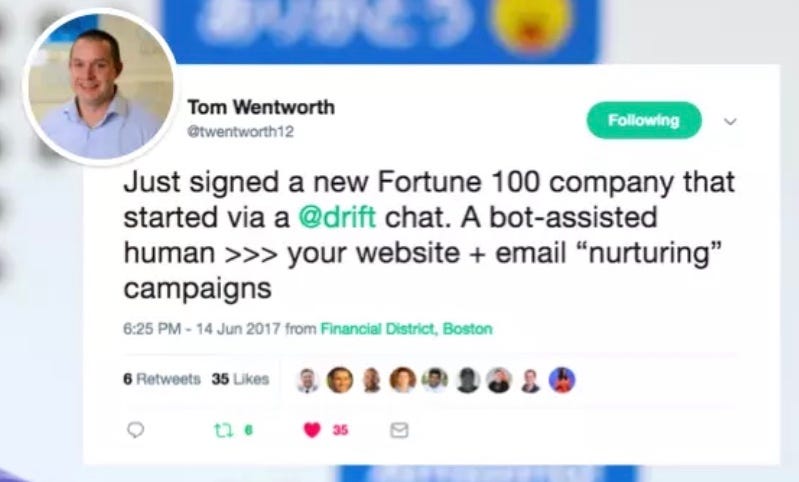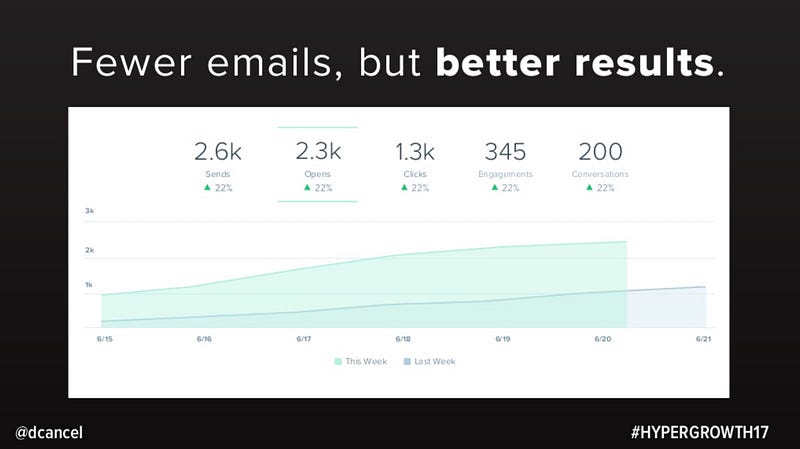A few weeks ago, I met a CMO named Yvette in the office kitchen at OpenView Venture Partners. She was chewing on a bagel during a lunch break from the VC firm’s all-day speaker event, and she was clearly upset.
“How in the world,” Yvette said, reaching for the cream cheese, “am I going to inform my team that our entire approach to marketing is wrong?”
The CEO of another company, overhearing Yvette, chimed in. “Right? I just texted my VP of sales that the way we’re selling is obsolete.”
In fact, virtually every CEO, sales exec, and marketing VP in attendance seemed suddenly overwhelmed by an urgent desire to change the way they worked.
The reason?
They had just been on the receiving end of the best sales pitch I’ve seen all year.
The 5 Elements of Drift’s Powerful Strategic Narrative
There were many great speakers at OpenView’s Boston headquarters that morning — JetBlue’s VP of marketing, senior execs from OpenView’s portfolio—yet none moved the crowd quite like Drift director of marketing Dave Gerhardt. By the time Gerhardt was finished, the only attendees who weren’t plotting to secure budget for Drift’s platform were the ones humble-bragging about how they’d already implemented it.
How did Gerhardt do it? For that matter, how has Drift—a web-based, live-chat tool for salespeople and marketers—managed to differentiate itself in a market crowded with similar offerings? (The company recently raised a $32 million round of Series B capital led by General Catalyst, with participation from Sequoia, and boasts over 40,000 businesses on its platform.)
The answer to both starts with a brilliant strategic narrative, championed by Drift CEO David Cancel, that has transformed the company into something more like a movement. In fact, two weeks after hearing Gerhardt speak, I saw Cancel pitch a new feature at Drift’s day-long Hypergrowth event, and he told virtually the same story, to similar effect.
Here, then, are the 5 elements of every compelling strategic story, and how Drift is leveraging them to achieve breakout success. If you’re pitching anything to anyone, lay them out in exactly this order:
(I have no financial stake in Drift. However, I saw Cancel pitch at Hypergrowth because I also spoke at the conference. The images below are a mix of Gerhardt’s OpenView slides and Cancel’s from Hypergrowth.)
#1. Start with a big, undeniable change that creates stakes
No matter what you’re selling, your most formidable obstacle is prospects’ adherence to the status quo. Your primary adversary, in other words, is a voice inside people’s heads that goes, We’ve gotten along just fine without it, and we’ll always be fine without it.
How do you overcome that? By demonstrating that the world has changed in such a fundamental way that prospects have to change, too.
Drift kicks off its strategic narrative with a dramatic change in the life of a typical business buyer. She’s so connected now that she practically sleeps with her phone:
And her preferred way to interact—professionally and socially—is through always-on messaging platforms like Facebook Messenger, SMS, Instagram, and Slack:
Note that the change Drift talks about is (1) undeniably happening and (2) happening independently of Drift — that is, whether Drift exists or not. It also (3) gives rise to stakes. All three must be true if you want prospects’ trust as you lead them down the path of questioning their love for the status quo.
While Drift’s slides don’t name the stakes explicitly, Cancel and Gerhardt’s voiceovers make them clear enough: Interact with prospects through these new channels—in real time—or don’t interact with them at all.
#2. Name the enemy
Luke fought Vader. Moana battled the Lava Monster. Marc Benioff squared off against software.
One of the most powerful ways to turn prospects into aspiring heroes is to pit them against an antagonist. What’s stopping marketers and salespeople—the heroes of Drift’s strategic story—from reaching prospects in the new, changed world?
According to Drift, it’s tools of the trade like lead forms— “fill in your name, company, and title, and maybe we’ll get back to you”— designed for a bygone era:
Drift even steals a page from Salesforce’s “no software” playbook, except here it’s those “forms” that play the role of villain:
Naming your customer’s enemy differentiates you — not directly in relation to competitors (which comes off as “salesy”), but in relation to the old world that your competitors represent. To be sure, “circle-slash” isn’t the only way to do that, but once you indoctrinate audiences with your story, icons like this can serve as a powerful shorthand. (I bet the first time you saw Benioff’s “no software” image, you had no idea what he was talking about; once you heard the story, it spoke volumes.)
Incidentally, both Cancel and Gerhardt execute a total ninja move by including themselves in the legions of marketers and salespeople seduced by the enemy—that is, brought up to believe that phone calls, forms and email are how you reach prospects. (Cancel was, after all, chief product officer at Hubspot, a big enabler of forms.) In their story, it’s not you who needs help, but we:
Drift isn’t pointing an accusatory finger at your problem. Instead, they’re inviting you to join them in a revolution, to fight with them against a common foe.
#3. Tease the “Promised Land”
In declaring the old way to be a losing path, Drift plants a question in audiences’ minds: OK, so how do I win?
It‘s tempting to answer that question by jumping right to your product and its capabilities, but you’ll be wise to resist that urge. Otherwise audiences will lack context for why your capabilities matter, and they’ll tune out.
Instead, first present a glimpse of the “Promised Land “— the state of winning in the new world. Remember, winning is not having your product but the future that’s possible thanks to having your product:
It’s wildly effective to introduce your Promised Land, as Drift does, so it feels like we’re watching you think it through (“what we realized was”). However you do it, your Promised Land should be both (a) desirable (obviously) and (b) difficult for prospects to reach without you. Otherwise, why do you exist?
#4. Position capabilities as “magic” for slaying “monsters”
Once audiences buy into your Promised Land, they’re ready to hear about your capabilities. It’s the same dynamic that plays out in epic films and fairy tales: We value Obiwan’s gift of a lightsaber precisely because we understand the role it can play in Luke’s struggle to destroy the Death Star.
So yes, you’re Obiwan and your product (service, proposal, whatever) is a lightsaber that helps Luke battle stormtroopers. You’re Moana’s grandmother, Tala, and your product is the ancient wisdom that propels Moana to defeat the Lava Monster.
Drift’s “magic” for annihilating forms is an always-on chat box that prospects see when they visit your website:
Cancel’s keynote doubled as a launch announcement for a new feature called Drift Email, so he transitioned next to another monster that’s keeping people from reaching Drift’s conversational Promised Land:
Email, obviously, would be a way to facilitate that. But wait, wasn’t email the enemy—or at least an evil henchman?
Well, if the Terminator can be resurrected as a force for good (Terminator 2), then email can be too. Cancel lays out three “mini-monsters” blocking that transformation:
Then he introduces Drift Email—not as a set of context-free features or even benefits, but as a collection of magic for slaying the monsters. With Drift Email, your prospects can react to an email instantly by, for instance, booking a demo without waiting for you to email them back:
After a prospect returns to your website by responding to an email, you can continue the conversation in a relevant way, rather than by bombarding the prospect with more emails:
And no matter what channel the prospect wanted to talk through next, the context (history, etc.) persists:
#5. Present your best evidence
Of course, even if you’ve laid out the story perfectly, audiences will be skeptical. As they should be, since your Promised Land is by definition difficult to reach!
So you must present evidence of your ability to deliver happily-ever-after. The best evidence is stories about people—told in their own voices—who say you helped reach the Promised Land:
What if you’re so early that you’re not yet blessed with a stack of glowing success stories and testimonials? That must have been the case with Drift Email, so Cancel had his team dogfood it (use it themselves) and showed the results:
Drift’s Story Works Because They Tell It Everywhere—and Commit to Making It Come True
Whether I’m running a strategic messaging and positioning project for a CEO and his/her leadership team, or training larger sales and marketing groups, I use the framework above to help them craft a customer-centric narrative, as Cancel has. But that’s just the first step.
To achieve what Drift has, the CEO (or whatever the leader is called) must commit to telling the story over and over through all-hands talks, recruiting pitches, investor presentations, social channels — everywhere — and to making it come true.
That’s what Cancel does. His entire team seems maniacally focused on getting customers to the Promised Land — through sales conversations, customer interactions, marketing collateral, success stories, events, and podcasts. Even product: Once you pinpoint the Promised Land, you see monsters everywhere, each an opportunity for profitable new features. Among the questions Gerhardt received from the audience at OpenView: How do we schedule salespeople for live-chat duty? How do we qualify prospects if every one of them gets to chat with you? If Drift hasn’t already conjured up magic for taming those beasts, I’m guessing it’s on its way.
The Rise of Story-Led Differentiation
If I had any doubt that Cancel believes, as I do, that it’s more important now than ever to differentiate through a customer-centric strategic narrative, it was erased when, a few days later, he posted this on Linkedin:
Some commenters disagreed, but most wanted to know what he meant by “act accordingly.” Cancel never responded, but his actions—and Drift’s success—scream his answer.
Product differentiation, by itself, has become indefensible because today’s competitors can copy your better, faster, cheaper features virtually instantly. Now, the only thing they can’t replicate is the trust that customers feel for you and your team. Ultimately, that’s born not of a self-centered mission statement like “We want to be best-in-class X” or “to disrupt Y,” but of a culture whose beating heart is a strategic story that casts your customer as the world-changing hero.
That’s the big, undeniable shift in the world that I spoke about as the final speaker at OpenView that day, several hours after Gerhardt left the stage.

